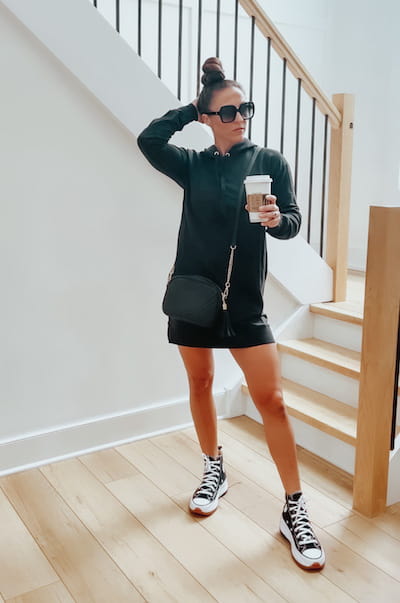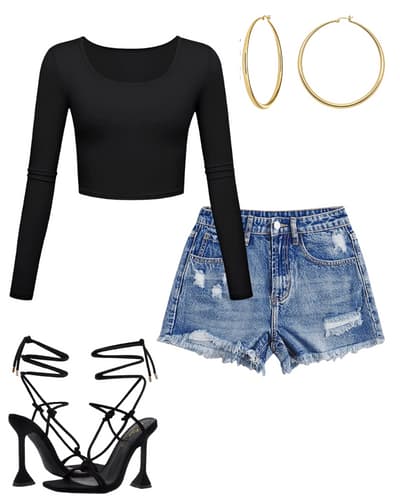Tencel Vs Modal: Differences & Benefits
If you don’t know the difference between tencel vs modal, don’t worry, most people don’t! Tencel and modal are two fabrics that are often used in clothing, bedding, and upholstery.
They are both derived from natural sources and have many similarities, but there are also a few key differences that make them each unique.
These fabrics are made from wood chips, believe it or not, each from different trees but with the same chemicals for processing. Both tencel and modal are relatively new to the textile industry, and their differences are worth discussing because they each have unique benefits and uses in the fashion industry.

What is Tencel?
Tencel actually refers to a brand name created by the Austrian company Lenzing AG.
The trademark for TENCEL™ refers to their process for creating their TENCEL™ modal fabric, which is made from a set of fibers called lyocell and modal. Typically when someone just says tencel, they are referring to lyocell.
Tencel lyocell is a fabric made from wood pulp, typically from eucalyptus trees or pine trees. It has a soft and luxurious feel, similar to cotton fabrics and silk, and is usually used in high-end clothing. It is a lightweight fabric that is breathable, absorbent, and wrinkle-resistant.
Tencel is also hypoallergenic and resistant to static, which makes it a great choice for people with sensitive skin. It’s also resistant to shrinking, fading, and pilling, and can be machine washed and dried.
Lyocell is a semi-synthetic fabric made from cellulose, which is a fibrous material derived from plants.
The process begins with dissolving the cellulose fibres in a solution of amine oxide, which is a chemical compound. This solution is then passed into a spinneret, a device with many tiny holes, which forms the cellulose into strands.
These strands are then dried, heated, and stretched to create long, continuous fibers. The fibers are then twisted and woven together to form the fabric.
What is Modal?
Modal, also made by the brand TENCEL™, is a fabric made from reconstituted cellulose derived from beech trees. It is soft and silky, similar to tencel, but is slightly more durable. It is breathable, absorbent, and resistant to wrinkling.
Modal is also resistant to fading and is safe in a washing machine, it’s hypoallergenic and resistant to static. Modal fabric is typically used to make lingerie, loungewear, pajamas, robes, and nightgowns. It is also used to make bedding, curtains, and other home decor items.
Modal, also a semi-synthetic fabric, is made much the same way lyocell is made. Modal production is done by spinning beech tree cellulose fibers into a yarn. The yarn is then woven and the final product is a soft, breathable, and strong fabric.
Modal is commonly used as a blend with other fabrics such as cotton or polyester to create a more durable fabric.
Tencel Modal is just a combination of TENCEL™ lyocell and modal. These two fibers combined provide luxury, strength, and durability.
Natural Vs Semi-Synthetic Fabrics
Both lyocell and modal are both considered semi-synthetic fabrics and are often used as a substitute for cotton or silk. Natural fabrics are fabrics that are made from natural materials like cotton, silk, wool, and linen. These fabrics are woven from fibers that are harvested from plants, animals, or insects.
Semi-synthetic fabrics are fabrics that are made from a combination of natural and synthetic fibers. These fabrics are usually durable and less prone to wrinkling than natural fabrics.
Semi-synthetic fabrics are often more affordable than natural fabrics and can be used for a variety of applications. Semi-synthetic fabrics are not as breathable or quite as soft as natural fabrics.
However, they can be very similar, like in the case of lyocell and modal. Both are soft fabrics that can be very easily mistaken for natural fabrics.

Tencel vs Modal
Both tencel lyocell and Modal have a number of advantages. They are lightweight and breathable, making them ideal for warm-weather clothing. They are also absorbent, making them great for people who sweat a lot.
Both fabrics are resistant to shrinking, fading, and wrinkling, making them easy to care for. They are also hypoallergenic and resistant to static, making them a great choice for people with sensitive skin.
Additionally, both fabrics have a reduced environmental impact even though modal isn’t a totally natural material.
The main difference between tencel lyocell fabric and modal fabric is that tencel is made from eucalyptus wood pulp and modal is made from beech wood pulp.
Tencel is derived from wood pulp, while Modal fibers are derived from reconstituted cellulosic fibers. Tencel is slightly softer than Modal, but Modal is slightly more durable.
In terms of cost, tencel is usually more expensive than modal, but both fabrics are considered to be eco-friendly. Overall, both tencel and modal are great fabrics that have many advantages.
Tencel Lyocell Vs Modal Clothing
Tencel lyocell, made from a sustainable source of natural fibers, is much like silk in that it wrinkles easily and becomes weak when wet. Lyocell tends to be used to make higher-end clothing.
Lyocell should be handled much more carefully than modal clothing to avoid damage and premature wear and tear.
You should never use bleach or fabric softener on lyocell fabric. Products like these weaken the integrity of the fabric, but we’ll talk about caring for these materials down below.
Modal fabric is very durable and can last a long time if cared for properly. It is known for its softness, strength, and resistance to fading, shrinking, and pilling. It is also resistant to mildew and wrinkles, making it a great choice for clothing and upholstery.
Lyocell is often used in women’s blouses, skirts, and other types of clothing as well as household items and decor. Here are some clothing options made with lyocell:

Women’s Lyocell Paper Bag-Waist Pant

Women’s Tencel Short-Sleeve Wrap Romper

Women’s Short Stop Lyocell Ruched Shoulder Top

Women’s Soft Tencel Denim Shirts Casual 3/4 Sleeve Button Down
Modal fabric is usually used in sleepwear, activewear, underwear, and lingerie. Here are some clothing options made with modal:

Women Modal Long Sleeve T-Shirt Under Scrub Scoop Neck Top

Women’s Oversized Terry Cotton and Modal Wide Leg Pant

Womens Soft Pajamas Sets Modal Long Sleeve Loungewear Pjs Set

Women’s Standard Sandwashed Modal Blend Jogger Pant
Tencel Lyocell vs Tencel Modal Sheets
When it comes to bedding, lyocell and modal are so close to the same material, but still different. Tencel, being made of all natural fibres, is a higher priced product, while modal will have a lower price tag. Lyocell is a longer-lasting fabric which makes it a good choice for bedding.
Both lyocell and modal may be longer lasting than cotton sheets. Both types of tencel sheets are popular choices if you’re looking for high-quality, soft bed sheets that will last a long time.
Here are some of our favorite bed sheet options:


Lightweight Cooling Eucalyptus Tencel Comforter

Brielle Home Tencel Modal Bed Sheets

Brielle Home Modal T-Shirt Jersey Knit Comforter
Tencel Lyocell Care Instructions
Lyocell is a higher-end fabric and it’s important to follow the manufacturer’s care instructions to ensure the fabric remains in its best condition.
When washing tencel lyocell, it’s best to hand-wash the garment in cold water with mild detergent. Do not use any fabric softener, bleach, or other harsh chemicals, because these can damage the fabric. If you have to machine-wash the garment, use a gentle cycle and a mild detergent.
It’s best to air-dry the lyocell fabric because heat can damage the fabric. When it comes to ironing, lyocell should be ironed on the lowest setting. Avoid using steam, as this can cause the fabric to shrink.
It is also important to avoid direct sunlight to avoid causing the fabric to fade. When it comes to storing tencel lyocell clothing, it is best to store this fabric in a cool, dry place away from direct sunlight. The fabric should be folded to avoid creasing and should not be hung as this can cause stretching.
If you follow these care instructions, your tencel lyocell garments will retain their shape and color for many years to come.
Tencel Modal Care Instructions
While tencel modal is known for its softness and comfort, it is also a delicate fabric that requires special care when laundering.
To make sure you keep your tencel modal clothing looking its best, always follow the manufacturer’s care instructions. Use a gentle detergent and wash on Delicate Cycle. Skip the fabric softener because it can damage tencel modal fabric.
If you want to soften your fabric, opt for a gentle and natural fabric softener like wool dryer balls. Whatever you do, don’t overload the washer. Tencel modal is a delicate fabric.
Tencel modal should never be put in the dryer. Instead, hang the garments on a line or drying rack to air dry. If you need to speed up the drying process, lay the garments flat on a towel and use a fan to blow air over them.
Iron on low heat if you need to iron your tencel modal garments. The lowest setting on your iron is best for this fabric. It’s also a good idea to use a pressing cloth to avoid scorching the fabric. Following these care instructions will help keep your tencel modal garments looking their best for a long time!
FAQs
What material is closest to modal?
Modal is a type of rayon fabric, so any other type of rayon fabric is closest to modal.
What is the generic name for tencel?
The generic name for tencel is lyocell.
Does Tencel shrink when washed?
Yes, tencel fabric can shrink when washed. To prevent shrinkage, it’s best to wash tencel fabric in cold water and either hang dry or dry on a low heat setting.
Is Tencel modal better than cotton?
Tencel and modal fabrics are both considered to be eco-friendly and sustainable fabrics. While cotton is also considered to be a sustainable fabric, tencel and modal fabrics are generally softer and more absorbent than cotton, making them better for certain applications. tencel and modal fabrics also tend to be more durable than cotton. Ultimately, which fabric is better depends on personal preference and what the fabric is being used for.
What are other names for Tencel?
Tencel is also known as Lyocell, Microfiber, and Viscose Rayon.
Is Tencel a cheap fabric?
No, tencel is not a cheap fabric. It is usually more expensive than other fabrics because of its unique properties and high quality.
Does modal fabric shrink in the dryer?
No, it is best not to put modal fabric in the dryer. Modal is a type of rayon fabric, and it is prone to shrinkage and wrinkling when exposed to high heat.
Other Posts You Might Like:





